fog light CHEVROLET S10 1993 2.G Owners Manual
[x] Cancel search | Manufacturer: CHEVROLET, Model Year: 1993, Model line: S10, Model: CHEVROLET S10 1993 2.GPages: 356, PDF Size: 20.85 MB
Page 13 of 356
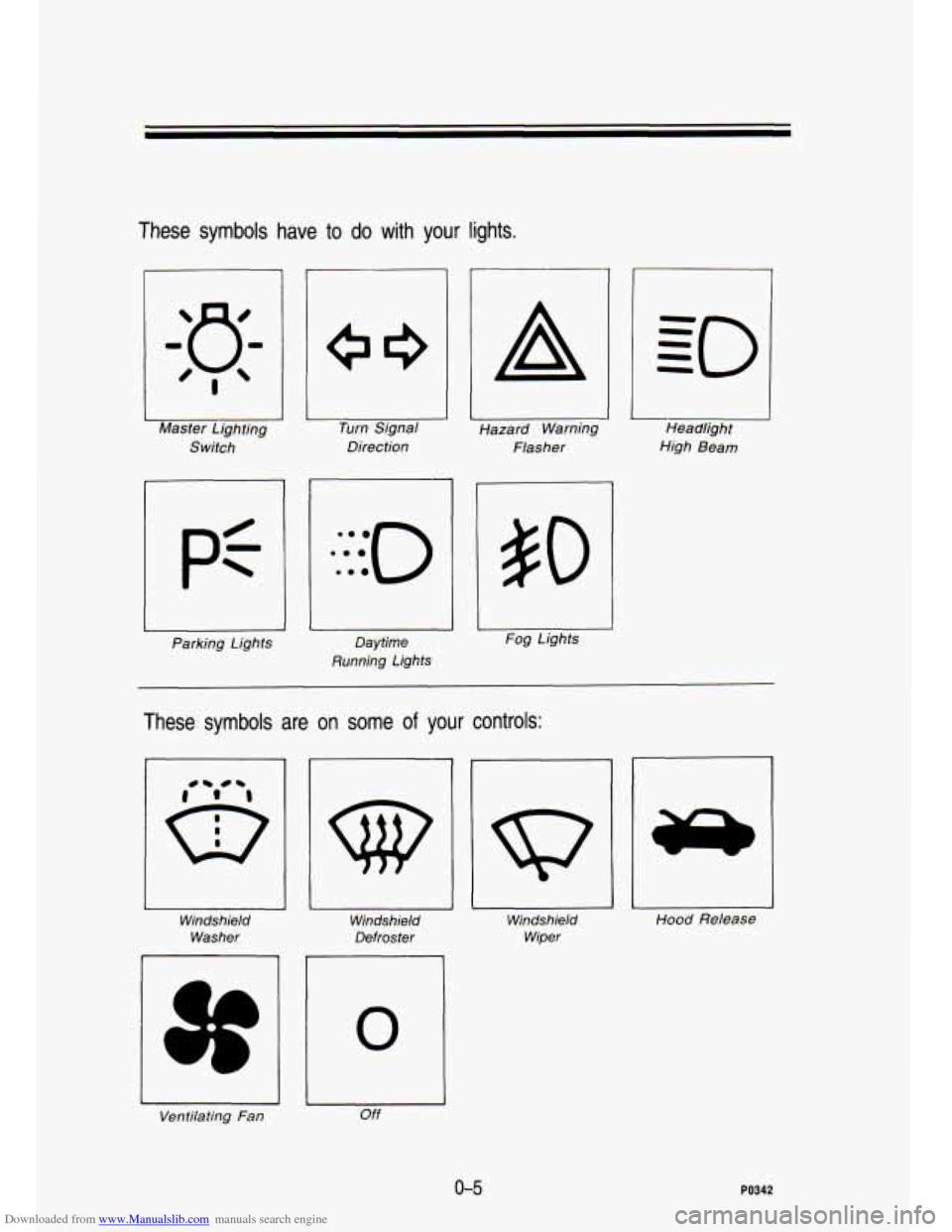
Downloaded from www.Manualslib.com manuals search engine These symbols have to do with your
- q-
‘I
Master Lighting Switch
Parking Lights I Turn Signal
Direction
u
Daytime
Running Lights
lights.
r
A
Hazard Warning Flasher
fog Lights
I Headlight
High Beam
These symbols are on some of your controls:
Windshield Washer
Ventilating Fan Windshield
Defroster
0
Off
2
Windshield Wiper Hood Release
0-5 PO342
Page 89 of 356
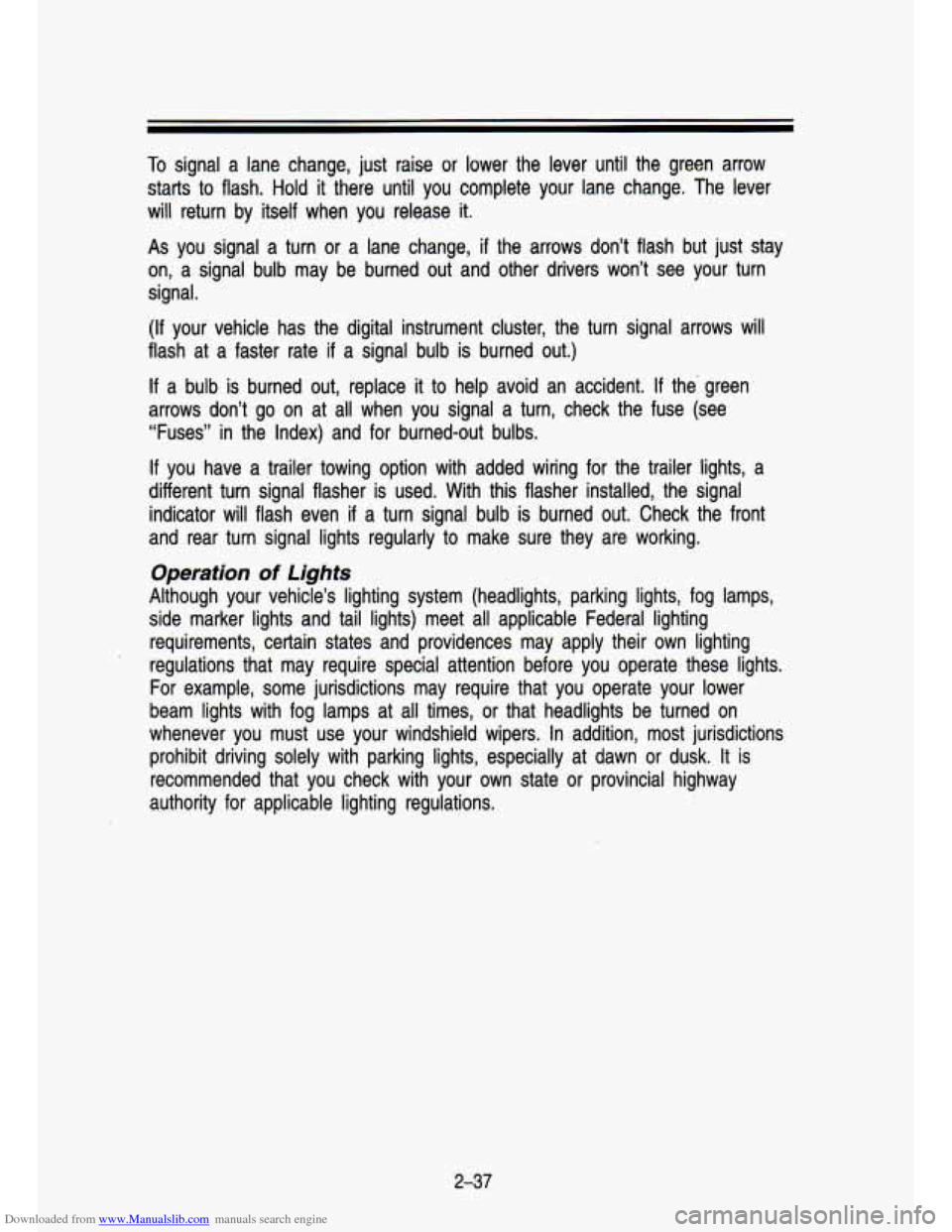
Downloaded from www.Manualslib.com manuals search engine To signal a lane change, just raise or lower the lever until the green ar\
row
starts to
flash. Hold it there until you complete your lane change. The lever
will return by itself when you release it.
As you signal a turn or a lane chi' -- if the arrows don’t flash but just stay
on, a signal bulb may be burned
OUT and other drivers won’t see your turn
signal.
(If your vehicle has the digital instrument cluster, the turn signa\
l arrows will
flash at a faster rate
if a signal bulb is burned out.)
If a bulb is burned out, replace it to help avoid an accident. If the green
arrows don’t go on at all when you signal a turn, check the fuse (see
“Fuses” in the Index) and for burned-out bulbs.
If you have a trailer towing option with added wiring for the tr\
ailer lights, a
different turn signal flasher is used. With this flasher instal\
led, the signal indicator will flash even if a turn signal bulb is burned out\
. Check the front
and rear turn signal lights regularly to make sure they are working.
Operation of Lights
Although your vehicle’s lighting system (headlights, parking \
lights, fog lamps,
side marker lights and tail lights) meet all applicable Federa\
l lighting
requirements, certain states and providences may apply their own\
lighting
regulations that may require special attention before you operat\
e these lights. For example, some jurisdictions may require that you operate yo\
ur lower
beam lights with fog lamps at all times, or that headlights b\
e turned on
whenever you must use your windshield wipers. In addition, most\
jurisdictions
prohibit driving solely with parking lights, especially at dawn \
or dusk.
It is
recommended that you check with your own state or provincial h\
ighway
authority for applicable lighting regulations.
2-37
Page 99 of 356
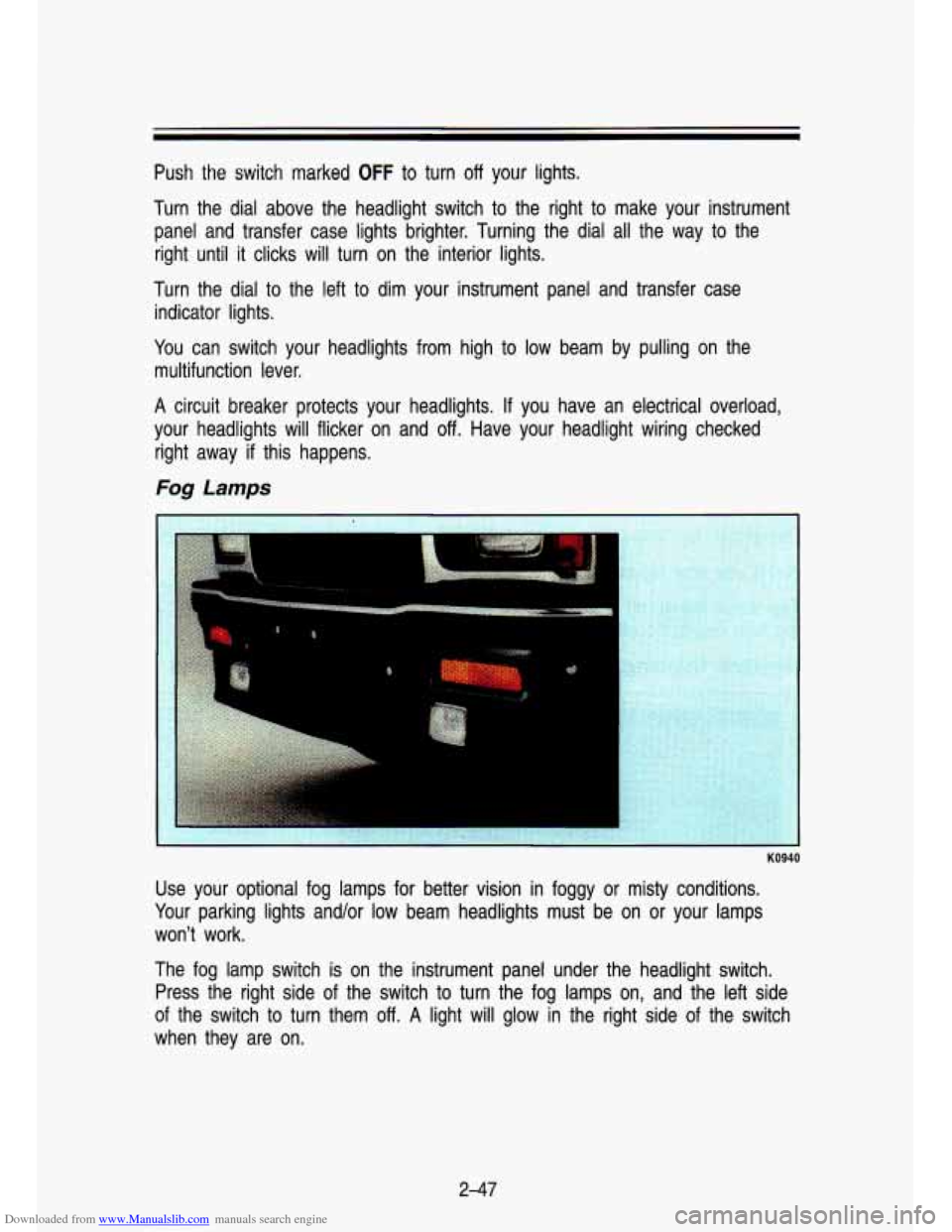
Downloaded from www.Manualslib.com manuals search engine Push the switch marked OFF to turn off your lights.
Turn the dial above the headlight switch to the right to make your instrument
panel and transfer case lights brighter. Turning the dial all the way to the
right until it clicks will turn on the interior lights.
Turn the dial to the left to dim your instrument panel and transfer case
indicator lights.
You can switch your headlights from high to low beam by pulling on the
multifunction lever.
A circuit breaker protects your headlights. If you have an electrical overload,
your headlights will flicker on and
off. Have your headlight wiring checked
right away
if this happens.
Fog Lamps
KO940
Use your optional fog lamps for better vision in foggy or misty conditions.
Your parking lights and/or low beam headlights must be on or your lamps
won’t work.
The fog lamp switch is on the instrument panel under the headlight switch.
Press the right side of the switch to turn the fog lamps on, and the left side
of the switch to turn them
off. A light will glow in the right side of the switch
when they are on.
2-47
Page 100 of 356
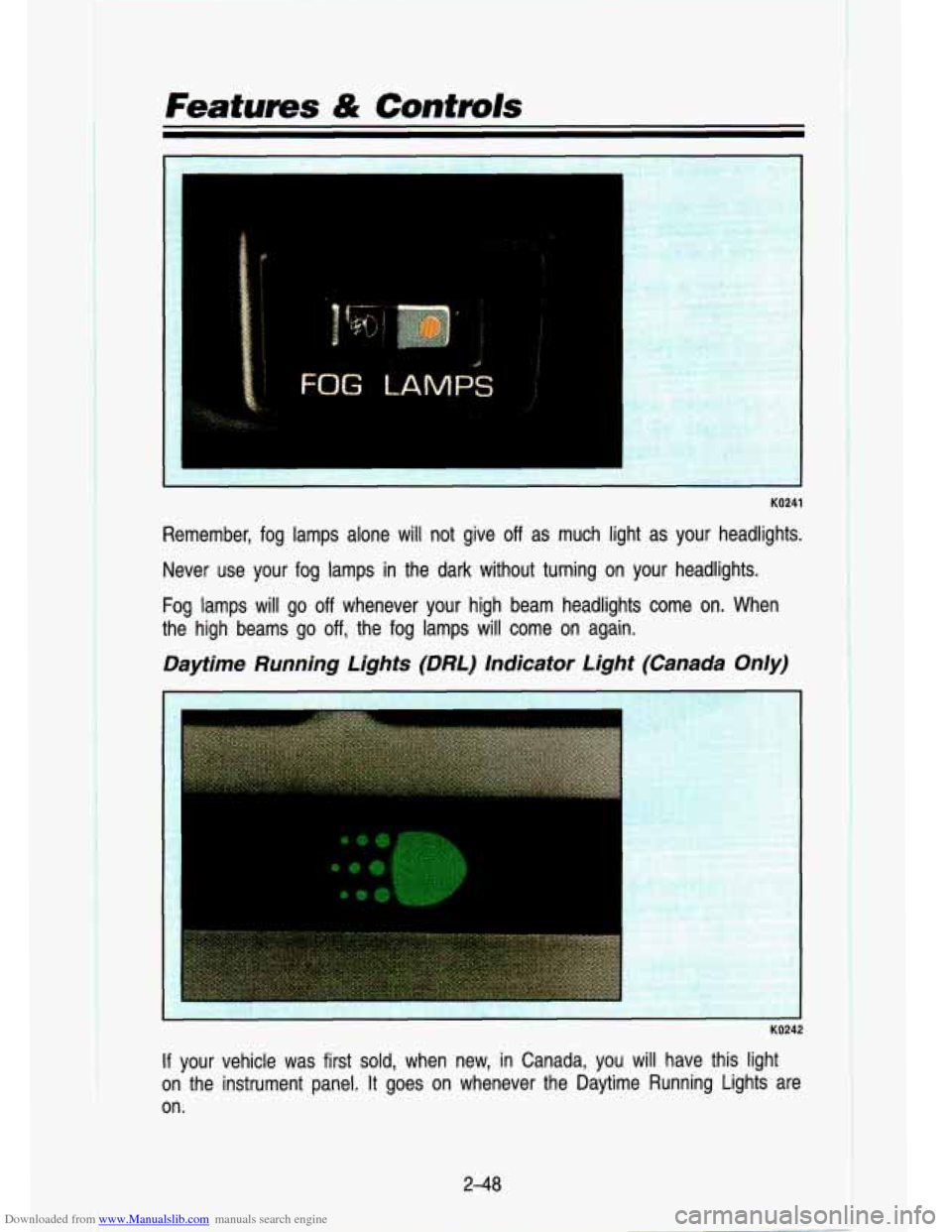
Downloaded from www.Manualslib.com manuals search engine Featums & Controls
KO241
Remember, fog lamps alone will not give off as much light as your headlights.
Never use your fog lamps in the dark without turning on your headlights.
Fog lamps will go
off whenever your high beam headlights come on. When
the high beams go off, the fog lamps will come on again.
Daytime Running Lights (DRL) Indicator Light (Canada Only)
r
KO242
If your vehicle was first sold, when new, in Canada, you will have this light
on the instrument panel. It goes on whenever the Daytime Running Lights are
on.
2-48
Page 193 of 356
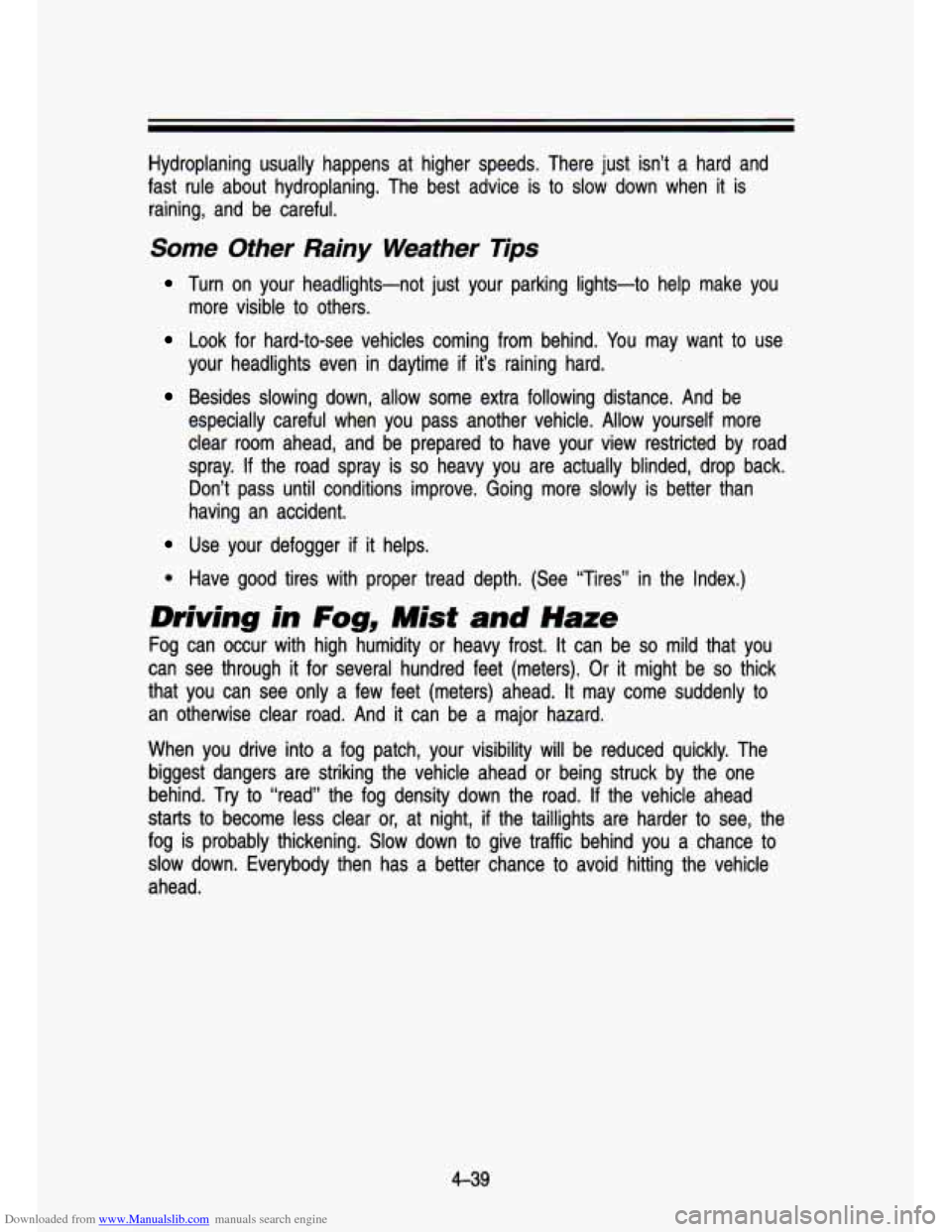
Downloaded from www.Manualslib.com manuals search engine Hydroplaning usually happens at higher speeds, There just isn’\
t a hard and
fast rule about hydroplaning. The best advice is to slow down \
when it is raining, and be careful.
?>me Other Rainy Weather Tips
Turn on your headlights-not just your parking lights-to help ma\
ke you
Look for hard-to-see vehicles coming from behind. You may want to use
more visible to others.
your headlights even in daytime
if it’s raining hard.
Besides slowing down, allow some extra following distance. And \
be
especially careful when you pass another vehicle. Allow yourself\
more
clear room ahead, and be prepared to have your view restricted\
by road
spray.
If the road spray is so heavy you are actually blinded, drop back.
Don’t
pass until conditions improve. Going more slowly is better than
having an accident.
Use your defogger if it helps.
0 Have good tires with proper tread depth. (See “Tires” in the Index.)
Driving in Fog, Mist and Haze
Fog can occur with high humidity or heavy frost. It can be so mild that you
can see through it for several hundred feet (meters). Or it might be
so thick
that you can see only a few feet (meters) ahead.
It may come suddenly to
an otherwise clear road. And it can be a major hazard.
When you drive into a fog patch, your visibility will be redu\
ced quickly. The biggest dangers are striking the vehicle ahead or being struck \
by the one
behind. Try to “read” the fog density down the road.
If the vehicle ahead
starts
to become less clear or, at night, if the taillights are harder to see, the
fog is probably thickening. Slow down
to give traffic behind you a chance to
slow down. Everybody then has a better chance to avoid hitting\
the vehicle
ahead.
Page 194 of 356
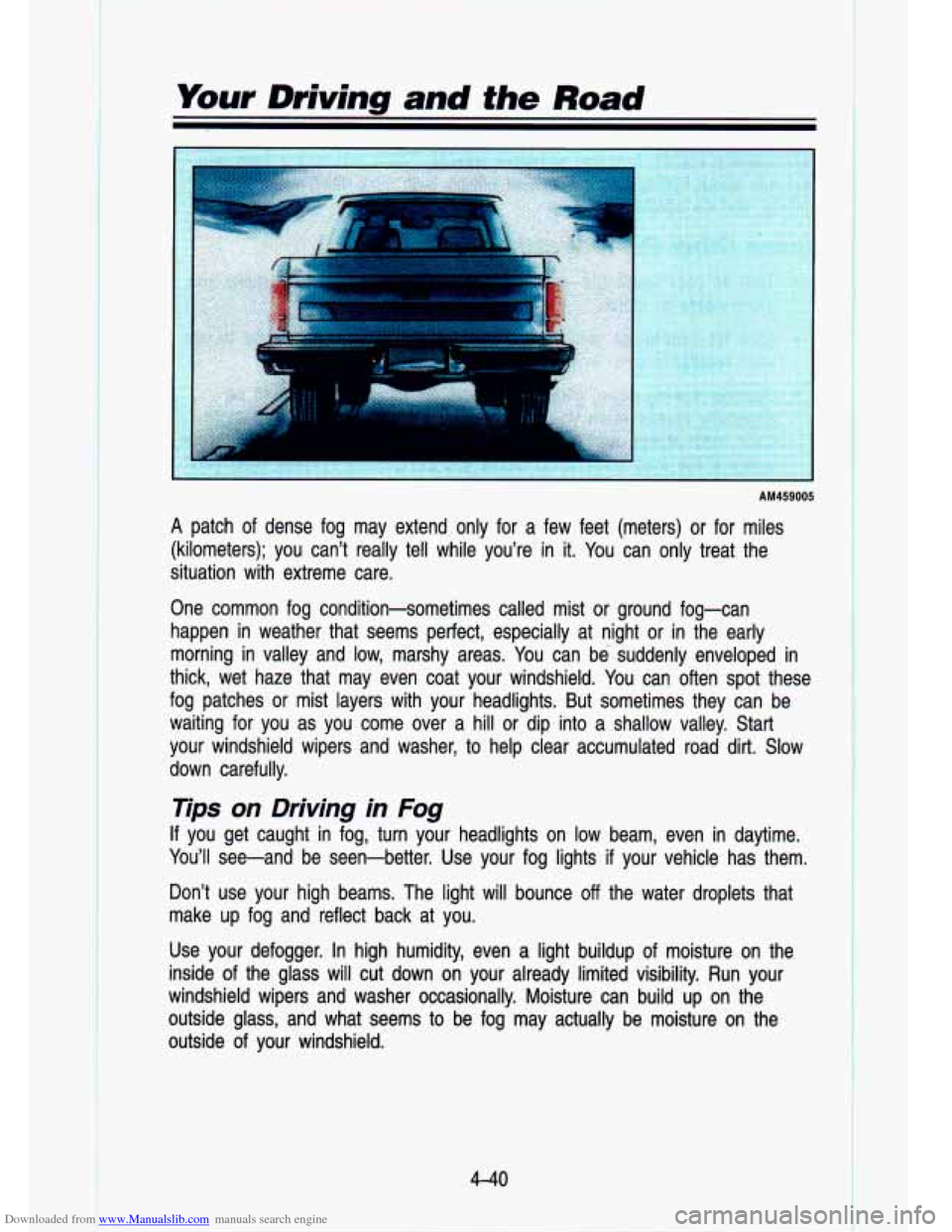
Downloaded from www.Manualslib.com manuals search engine I. Your Driving and the Road
I-
AM459005
A patch of dense fog may extend only for a few feet (meters) or fo\
r miles
(kilometers); you can't really tell while you're in it. You can only treat the
situation with extreme care.
One common fog condition-sometimes called mist or ground fog-can
happen in weather that seems perfect, especially at night or in the early
morning in valley and low, marshy areas. You can be suddenly enveloped in
thick, wet haze that may even coat your windshield. You can o\
ften spot these
fog patches or mist layers with your headlights. But sometimes \
they can be
waiting for you as you come over a hill or dip into a shallow valley. Start
your windshield wipers and washer, to help clear accumulated ro\
ad dirt. Slow down carefully.
Tips on Driving in Fog
If you get caught in fog, turn your headlights on low beam, even in daytime.
You'll see-and be seen-better. Use your fog lights
if your vehicle has them.
Don't use your high beams. The light will bounce
off the water droplets that
make up fog and reflect back at you.
Use your defogger. In high humidity, even a light buildup of moisture on the
inside of the glass will cut down on your already limited visibility. Ru\
n your
windshield wipers and washer occasionally. Moisture can build up\
on the
outside glass, and what seems to be fog may actually be moisture on the
outside of your windshield.
..
_. , .
I t
4-40
R
Page 195 of 356
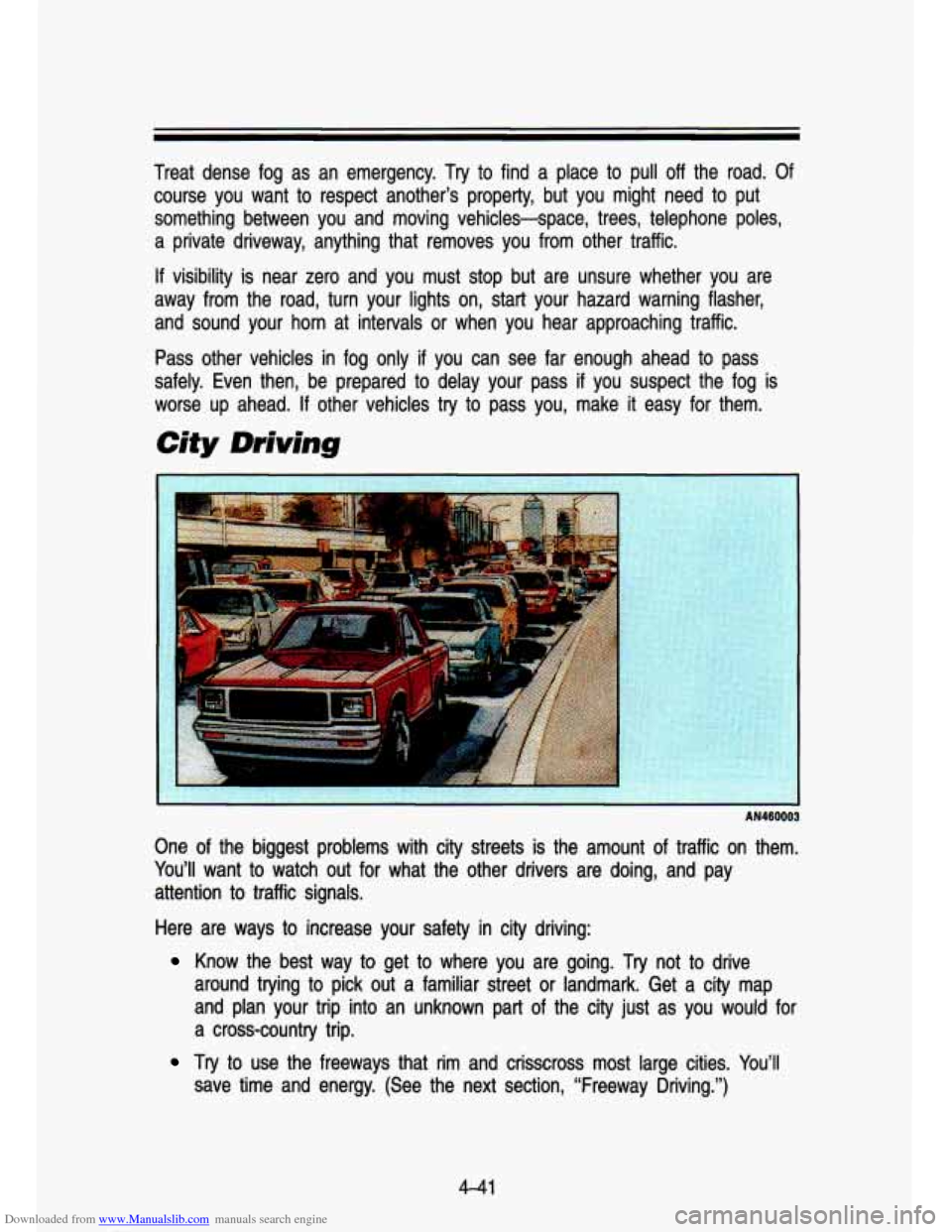
Downloaded from www.Manualslib.com manuals search engine Treat dense fog as an emergency. Try to find a place to pull\
off the road. Of course you want
to respect another’s property, but you might need to put
something between you and moving vehicles-space, trees, telephone\
poles,
a private driveway, anything that removes you from other traffi\
c.
If visibility is near zero and you must stop but are unsure whether you are
away from the road, turn your lights on, start your hazard wa\
rning flasher, and sound your horn at intervals
or when you hear approaching traffic.
Pass other vehicles in fog only
if you can see far enough ahead to pass
safely. Even then, be prepared to delay your pass
if you suspect the fog is
worse up ahead.
If other vehicles try to pass you, make it easy for them.
City Driving
AN460003
One of the biggest problems with city streets is the amount of traffic on them.
You’ll want to watch out for what the other drivers are doing, and pay
attention to traffic signals.
Here are ways
to increase your safety in city driving:
Know the best way to get to where you are going. Try not to drive
around trying
to pick out a familiar street or landmark. Get a city map
and plan your trip into an unknown part of the city just as you would for
a cross-country trip.
Try to use the freeways that rim and crisscross most large cities.\
You’ll
save time and energy. (See the next section, “Freeway Drivi\
ng.”)
4-41
Page 315 of 356
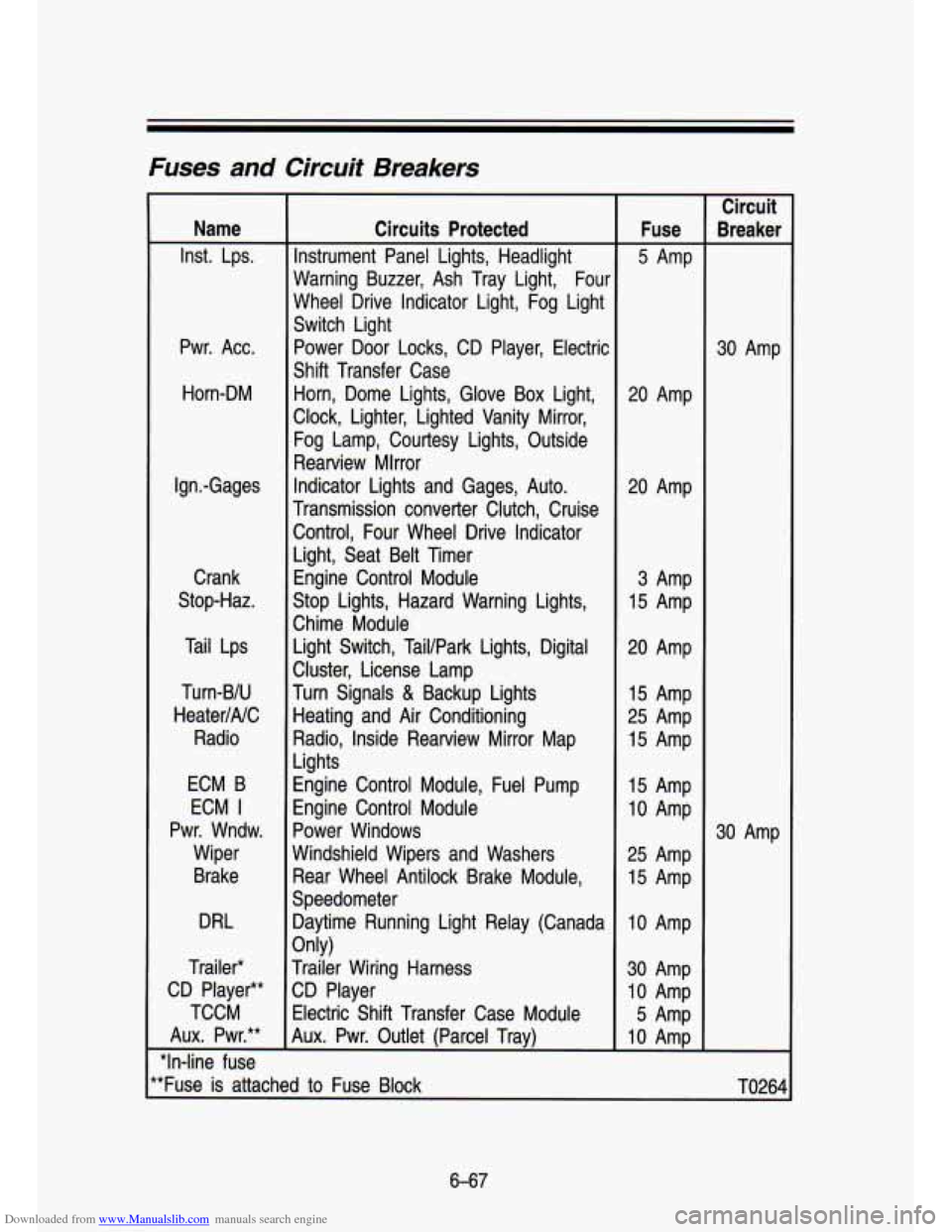
Downloaded from www.Manualslib.com manuals search engine Fuses and Circuit Breakers
Name
Inst. Lps.
Pwr. Acc. Horn-DM
Ign.-Gages Crank
Stop-Haz.
Tail Lps
Turn-BIU
HeaterINC Radio
ECM B
ECM
I
Pwr. Wndw. Wiper
Brake
DRL
Trailer*
CD Player**
TCCM
Aux. Pwr.**
"In-line fuse Circuits Protected
Instrument Panel Lights, Headlight
Warning Buzzer, Ash Tray Light, Four
Wheel Drive Indicator Light, Fog Light
Switch Light Power Door Locks, CD Player, Electric
Shift Transfer Case Horn, Dome Lights, Glove Box Light,
Clock, Lighter, Lighted Vanity Mirror,
Fog Lamp, Courtesy Lights, Outside
Rearview Mlrror
Indicator Lights and Gages, Auto.
Transmission converter Clutch, Cruise Control, Four Wheel Drive Indicator
Light, Seat Belt Timer Engine Control Module
Stop Lights, Hazard Warning Lights,
Chime Module Light Switch, Tail/Park Lights, Digital
Cluster, License Lamp
Turn Signals
& Backup Lights
Heating and Air Conditioning
Radio, Inside Rearview Mirror Map
Lights
Engine Control Module, Fuel Pump
Engine Control Module
Power Windows
Windshield Wipers and Washers Rear Wheel Antilock Brake Module,
Speedometer Daytime Running Light Relay (Canada
Trailer Wiring Harness
CD Player
Electric Shift Transfer Case Module
Aux. Pwr. Outlet (Parcel Trav)
Only) Fuse
5 Amp
20 Amp
20 Amp
3 Amp
15 Amp
20 Amp 15 Amp
25 Amp
15 Amp
15 Amp
10 Amp
25 Amp
15 Amp
10 Amp
30 Amp
10 Amp
5 Amp
10 AmD Circuit
kea ker
30 Amp
30 Amp
'*Fuse is attached to Fuse Block
TO264
6-67
Page 348 of 356
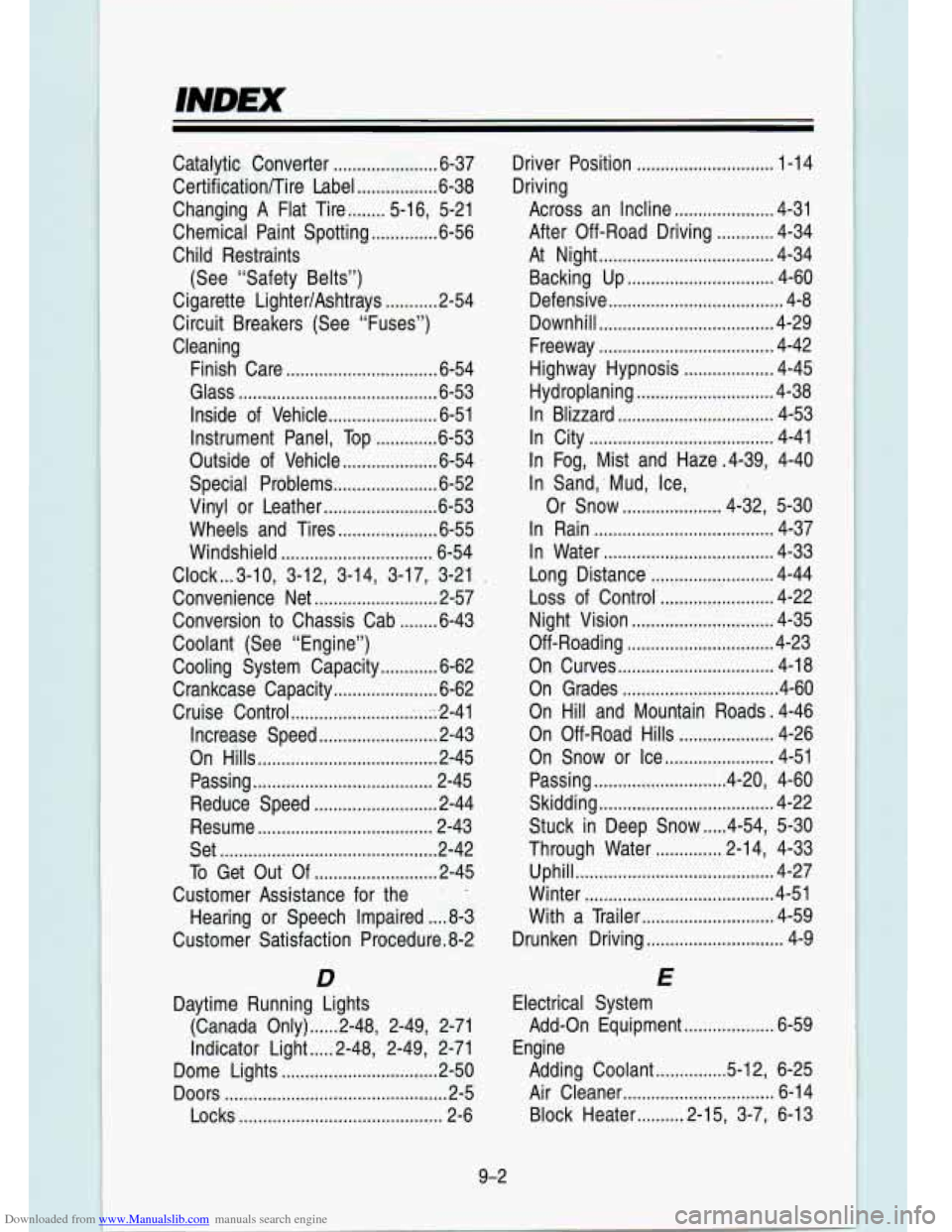
Downloaded from www.Manualslib.com manuals search engine INDEX
Catalytic Converter ......... ...... ..._. 6-37
CertificationlTire Label
................. 6-38
Changing A Flat Tire
........ 5-16, 5-21
Chemical Paint Spotting
.............. 6-56
Child Restraints
Cigarette LighterlAshtrays
........... 2-54
Circuit Breakers (See “Fuses”)
Cleaning (See “Safety
Belts”)
Finish Care
................................ 6-54
Glass
.......................................... 6-53
Inside of Vehicle
....................... 6-51
Instrument Panel, Top
............. 6-53
Outside
of Vehicle .................... 6-54
Special Problems
...................... 6-52
Vinyl or Leather
................-...... 6-53
Wheels and Tires
..................... 6-55
Windshield
................................ 6-54
Convenience Net
.......................... 2-57
Conversion
to Chassis Cab ........ 6-43
Coolant (See “Engine”)
Cooling System Capacity
............ 6-62
Crankcase Capacity
...................... 6-62
Cruise Control
................................ 2-41
Increase Speed
......................... 2-43
On Hills
...................................... 2-45
Passing
...................................... 2-45
Reduce Speed
......................... -2-44
Resume
..................................... 2-43
Set
.............................................. 2-42
To Get Out Of .......................... 2-45
Clock
... 3-10, 3-12,
3-14, 3-17, 3-21
Customer Assistance for the Hearing or Speech Impaired
.... 8-3
Customer Satisfaction Procedure.8-2
D
(Canada Only) ...... 2-48, 2-49, 2-71
Indicator Light
..... 2-48, 2-49, 2-71
Dome Lights
................................. 2-50
Doors
............................................... 2-5
Daytime Running Lights
Locks
........................................... 2-6 9-2 Driver Position
............................. 1-14
Driving Across an Incline
..................... 4-31
After Off-Road Driving
............ 4-34
At Night
..................................... 4-34
Backing Up
............................... 4-60
Defensive
..................................... 4-8
Downhill
..................................... 4-29
Freeway
..................................... 4-42
Highway Hypnosis
................... 4-45
Hydroplaning
............................. 4-38
In Blizzard
................................. 4-53
In City
....................................... 4-41
In Fog, Mist and Haze .4-39, 4-40
In Sand,
. Mud, Ice,
Or Snow
..................... 4-32, 5-30
In Rain
...................................... 4-37
In Water .................................... 4-33
Long Distance
.......................... 4-44
Loss of Control
........................ 4-22
Night Vision
.............................. 4-35
Off-Roading
............................... 4-23
On Curves
................................. 4-18
On Grades
................................. 4-60
On Hill and Mountain Roads
. 4-46
On Off-Road Hills
.................... 4-26
On Snow or Ice
....................... 4-51
Passing
............................ 4-20, 4-60
Skidding
..................................... 4-22
Stuck in Deep Snow
..... 4-54, 5-30
Through Water
.............. 2-14, 4-33
Uphill
.......................................... 4-27
Winter
........................................ 4-51
With a Trailer
............................ 4-59
Drunken Driving
............................. 4-9
E
Electrical System
Engine Add-on
Equipment
................... 6-59
Adding Coolant
............... 5-1 2, 6-25
Air Cleaner
................................ 6-14
Block Heater
.......... 2-15, 3-7, 6-13
Page 350 of 356
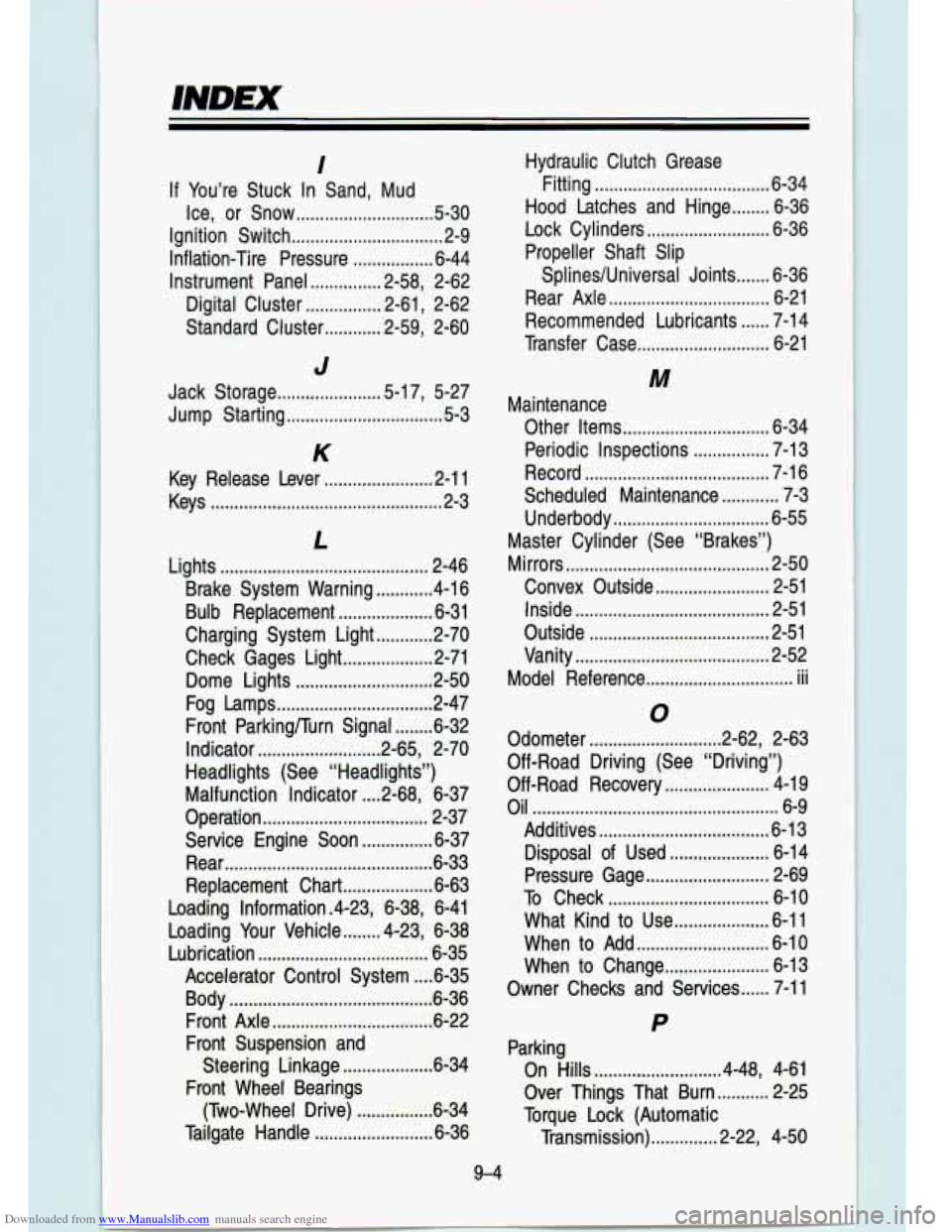
Downloaded from www.Manualslib.com manuals search engine I
If You’re Stuck In Sand. Mud
Ice. or Snow
............................. 5-30
Ignition Switch ................................ 2-9
Inflation-Tire Pressure ................. 6-44
Instrument Panel ............... 2-58, 2-62
Digital Cluster ................ 2-61, 2-62
Standard Cluster ............ 2-59, 2-60
J
Jack Storage ...................... 5-17, 5-27
Jump Starting ................................. 5-3
K
Key Release Lever ....................... 2-1 1
Keys ................................................. 2-3
L
Lights ........ ................................... 2-46
Brake System Warning ............ 4-1 6
Bulb Replacement .................... 6-31
Charging System Light ............ 2-70
Check Gages Light ................... 2-71
Dome Lights ............................. 2-50
Fog Lamps ................................. 2-47
Indicator ........................ ..2-65, 2-70
Headlights (See “Headlights”)
Malfunction Indicator
.... 2-68, 6-37
Operation ................................... 2-37
Service Engine Soon ............... 6-37
Rear ............................................ 6-33
Loading Information .4-23, 6-38, 6-41
Loading Your Vehicle ........ 4-23, 6-38
Lubrication .................................... 6-35
Front Parkingnurn Signal ........ 6-32
Replacement Chart ................... 6-63
Accelerator Control System .... 6-35
Body ........................................... .- 36
Front Axle ........................ ..... 6-22
Front Suspension and
Steering Linkage
................... 6-34
Front Wheel Bearings
(Two-Wheel Drive)
................ 6-34
Tailgate Handle ......................... 6-36
Hydraulic Clutch Grease
Fitting
..................................... 6-34
Hood Latches and Hinge ........ 6-36
Lock Cylinders .......................... 6-36
Propeller Shaft Slip
SplineslUniversal Joints
....... 6-36
Rear Axle .................................. 6-21
Recommended Lubricants ...... 7-14
Transfer Case ............................ 6-21
M
Other Items ............................... 6-34
Periodic Inspections ................ 7-13
Record ....................................... 7-16
Scheduled Maintenance ............ 7-3
Underbody ................................. 6-55
Master Cylinder (See “Brakes”)
Mirrors
........................................... 2-50
Convex Outside ........................ 2-51
inside ......................................... 2-51
Outside ...................................... 2-51
Vanity ......................................... 2-52
Model Reference ............................... iii
Maintenance
0
Odometer ............................ 2-62, 2-63
Off-Road Driving (See “Driving”)
Off-Road Recovery
...................... 4-1 9
Oil .................................................... 6-9
Additives .................................... 6-13
Disposal of Used ...................... 6-14
Pressure Gage .......................... 2-69
To Check .................................. 6-10
What Kind to Use .................... 6-11
When to Add ............................ 6-10
When to Change ...................... 6-13
Owner Checks and Services ...... 7-11
P
On Hills ........................... 4-48, 4-61
Torque Lock (Automatic
Parking
Over Things That Burn
........... 2-25
Transmission) .............. 2-22, 4-50